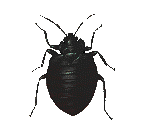General Characteristics:
- Found on all continents except Antarctica
- Mahogany to rusty brown in colour (turns red after a blood meal)
- Flattened and oval shaped body (becomes more round after feeding)
- Adult size is approximately 1/5-1/4 inches long and 1/8 inches wide
- Body appears shiny but is covered with tiny hairs
- Possesses piercing/sucking mouthparts
- May feed on any warm-blooded animal but primarily feeds on humans
- Although thought to transmit disease, clear evidence of this has not been verified, but bites may cause welts or irritation in certain individuals
- Primarily feeds at night but daytime feeding will occur if hungry
- Prefers dry, rough areas for dwelling
Reproduction:
- Males can mate with one or more females multiple times daily
- Males that have not fed in more than two weeks do not mate
- Males puncture female's body wall and inject sperm into her abdomen
- Eggs are elongated, asymmetrical and possess pink spots
- Females lay about 2 eggs per day until about 200 are laid
- At room temperature eggs will hatch in 6-17 days
- Nymph has the general shape of the adult but is colourless and will fully mature after 5 instars
Signs of Infestation:
- Emits a distinct odour from glands on thorax
- Lives and nests in a variety of harbourage areas including furniture, protected areas, cracks, gaps in structures, electrical fixtures, etc…
- May travel by wandering into suitcases, boxes, shoes, etc…
- Wandering insects may be observed
- Evidence of adults feces may be evident on bed sheets or other materials (blood spots)
- Biting/Feeding will occur on human bodies sometimes leaving welts or irritation
Control Techniques:
- Bedbugs are difficult to deal with and a professional should be contacted at all times to assess and treat infestations
- Physical removal and proper disposal of infested materials (beds, sheets, curtains, furniture) may be necessary
- Sealing all crevices will reduce harbourage areas and inhibit further breeding
- Chemical treatments may be necessary as determined by a professional
Please click here to contact a Focus Pest Control professional to inquire about further treatments for this pest species.
References:
Benett, Gary W., et.al.. Truman’s Scientific Guide to Pest Control Operations. Duluth: Advanstar Communications, 1988. Pp. 242-246.
"Bed Bugs" (On-line). National Pest Management Association Inc. Accessed Nov. 5, 2009 at http://www.pestworld.com/for-consumers/Pest-Guide/Pest/Bed-Bugs.
Schommer, M. 2000. "Cimex lectularius" (On-line), Animal Diversity Web. Accessed November 05, 2009 at http://animaldiversity.ummz.umich.edu/site/accounts/information/Cimex_lectularius.html.
Disclaimer:
The Focus Pest Control ‘Pest Library’ is an educational resource written largely to educate the general public about common pests in Ontario. The Focus ‘Pest Library’ does not include all species in Ontario, nor does it include the most recent scientific data about species we describe. Though we edit our accounts for accuracy, we cannot guarantee all information in those accounts. While Focus Pest Control staff and contributors provide references to books and websites that we believe are reputable, we cannot necessarily endorse the contents of references beyond our control.
(Back to top) |


